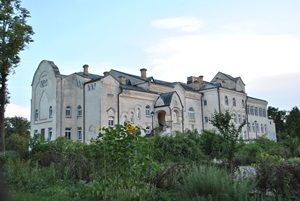Basilica of the Presentation of the Blessed Virgin Mary and the monastery complex in Różanystok
The most beautiful Baroque church in the Biebrza valley – Basilica of the Presentation of the Blessed Virgin Mary in Różanystok – stands among the fields. To see it, one has to go past the ponds which are the only the remnants of a manorial foundation of the Tyszkiewicz family. Here, in 1658, the first miracles in front of the painting of the Mother of Jesus took place. The painting was bought by the pantler Szczęsny Tyszkiewicz and his wife Eufozyna in 1652, probably in Grodno. Blossoming dry flowers, self-igniting oil lamps, a beautiful scent coming out from the painting, and finally inexplicable healings made the pantler and his family sure that had come in possession of a miraculous effigy. On a nearby hill they raised a wooden temple in 1661, and soon they brought priests of the Dominican Order to look after the painting of Mother of God.
After the death of the both founders in 1691 the monks took control of Różanystok and the nearby village of Stock, which was made over to them in the testament of the pantler and his wife. They were developing the cult of the painting for over 150 years, by publishing and republishing a book about the miracles made in front of the painting of Our Lady of Różanystok, running different missions and taking care of the material status of the foundation. In 1759, in the exact place where the wooden church had stood, they started the construction of a huge brick basilica, patterned upon a nearby Jesuits’ church in Grodno. Its equipment contained thirteen altars, a pulpit of the Vilnius type, a set of inlaid furniture and twenty-eight altar paintings by a Basilian monk Antoni Gruszecki. They depicted inter alia the Saints of the Order of Preachers: St. Dominic, Catherine of Siena, Thomas Aquinas, Vincent Ferrer. The church was surrounded with a stone wall, along which five rosary chapels were located. A festive consecration of the temple took place in 1785, and nine years later the construction of a new Dominican monastery was finished. Its plan resembled a Baroque palace.
However, the friars did not enjoy stability for long. In 1795 the Różanystok manor farm, which was incorporated into East Prussia, was confiscated, and the monks received an annual pay. In 1847 the parish was taken by diocesan priests. The last Dominican died in 1851. He was buried in a cemetery in Różanystok. His tombstone, situated in the centre of the cemetery, has a shape of a cuboid crowned with an obelisk. Another blow was closing the church in 1866 by the tsarist authorities. The same year it was given to the Orthodox clergy and soon works to prepare it for Eastern Rite liturgy were commenced. Two side altars, the organ, most statues and paintings were removed and given to the neighbouring parishes. The towers were surmounted with domes, and a wooden iconostasis was erected in front of the main altar. Nevertheless the cult of the miraculous painting still lasted, and the painting itself was put in a side altar to enable the worship by the faithful.
In 1901 the monastery complex with the church was given to an Orthodox women’s order by the tsarist government. The nuns started widely spread educational and charity work. They left an extensive complex of buildings, which has been preserved until this day. Among them there is a cloister edifice, called ‘Drapieżnik’ (from the Russian word ‘trapieznaja’ meaning ‘refectory’), a Neo-Romanesque Orthodox church of the Dormition of the Mother of God (currently: Catholic Chapel of Our Lady Help of Christians), beautifully decorated, wooden Zielona Willa (Green Villa), two brick school buildings (today of a junior high school and a Salesian dormitory), a brick and wooden one (former primary school), and a complex of brick structures situated in the eastern part of the establishment. The entire complex is surrounded with a stone wall, with a splendid gate situated opposite the church entrance.
The activity of the nuns was interrupted by the incidents of 1915. As they were forced to flee from the approaching front line, they took the miraculous painting with them. It has never returned to Różanystok. In 1919 the complex of residential-didactic buildings left by them, with the Dominican monastery and the church, was taken over by the Salesians, whose charism is working with the youth. Until 1954 they were running several educational institutions in Różanystok, including male junior high school, agricultural school and minor seminary. They were helped by Salesian nuns who came here in 1922, led by the Servant of God sister Laura Meozzi. It was the first monastic house of this congregation in Poland. After some unsuccessful attempts at reclaiming the miraculous painting of Our Lady from Różanystok, the Salesians ordered a ‘copy’ of it. The painting worshiped now, painted in 1928 by Jan Szewczyk, an artist from Warsaw, was granted papal crowns on 28th June 1981. After taking over the Salesian complex by the state in 1954, an Agricultural School Complex was located in the abandoned buildings. It operated there until 2007. In 2000 the Salesians regained their property and established an educational centre for boys here.

After the death of the both founders in 1691 the monks took control of Różanystok and the nearby village of Stock, which was made over to them in the testament of the pantler and his wife. They were developing the cult of the painting for over 150 years, by publishing and republishing a book about the miracles made in front of the painting of Our Lady of Różanystok, running different missions and taking care of the material status of the foundation. In 1759, in the exact place where the wooden church had stood, they started the construction of a huge brick basilica, patterned upon a nearby Jesuits’ church in Grodno. Its equipment contained thirteen altars, a pulpit of the Vilnius type, a set of inlaid furniture and twenty-eight altar paintings by a Basilian monk Antoni Gruszecki. They depicted inter alia the Saints of the Order of Preachers: St. Dominic, Catherine of Siena, Thomas Aquinas, Vincent Ferrer. The church was surrounded with a stone wall, along which five rosary chapels were located. A festive consecration of the temple took place in 1785, and nine years later the construction of a new Dominican monastery was finished. Its plan resembled a Baroque palace.
However, the friars did not enjoy stability for long. In 1795 the Różanystok manor farm, which was incorporated into East Prussia, was confiscated, and the monks received an annual pay. In 1847 the parish was taken by diocesan priests. The last Dominican died in 1851. He was buried in a cemetery in Różanystok. His tombstone, situated in the centre of the cemetery, has a shape of a cuboid crowned with an obelisk. Another blow was closing the church in 1866 by the tsarist authorities. The same year it was given to the Orthodox clergy and soon works to prepare it for Eastern Rite liturgy were commenced. Two side altars, the organ, most statues and paintings were removed and given to the neighbouring parishes. The towers were surmounted with domes, and a wooden iconostasis was erected in front of the main altar. Nevertheless the cult of the miraculous painting still lasted, and the painting itself was put in a side altar to enable the worship by the faithful.
In 1901 the monastery complex with the church was given to an Orthodox women’s order by the tsarist government. The nuns started widely spread educational and charity work. They left an extensive complex of buildings, which has been preserved until this day. Among them there is a cloister edifice, called ‘Drapieżnik’ (from the Russian word ‘trapieznaja’ meaning ‘refectory’), a Neo-Romanesque Orthodox church of the Dormition of the Mother of God (currently: Catholic Chapel of Our Lady Help of Christians), beautifully decorated, wooden Zielona Willa (Green Villa), two brick school buildings (today of a junior high school and a Salesian dormitory), a brick and wooden one (former primary school), and a complex of brick structures situated in the eastern part of the establishment. The entire complex is surrounded with a stone wall, with a splendid gate situated opposite the church entrance.
The activity of the nuns was interrupted by the incidents of 1915. As they were forced to flee from the approaching front line, they took the miraculous painting with them. It has never returned to Różanystok. In 1919 the complex of residential-didactic buildings left by them, with the Dominican monastery and the church, was taken over by the Salesians, whose charism is working with the youth. Until 1954 they were running several educational institutions in Różanystok, including male junior high school, agricultural school and minor seminary. They were helped by Salesian nuns who came here in 1922, led by the Servant of God sister Laura Meozzi. It was the first monastic house of this congregation in Poland. After some unsuccessful attempts at reclaiming the miraculous painting of Our Lady from Różanystok, the Salesians ordered a ‘copy’ of it. The painting worshiped now, painted in 1928 by Jan Szewczyk, an artist from Warsaw, was granted papal crowns on 28th June 1981. After taking over the Salesian complex by the state in 1954, an Agricultural School Complex was located in the abandoned buildings. It operated there until 2007. In 2000 the Salesians regained their property and established an educational centre for boys here.













